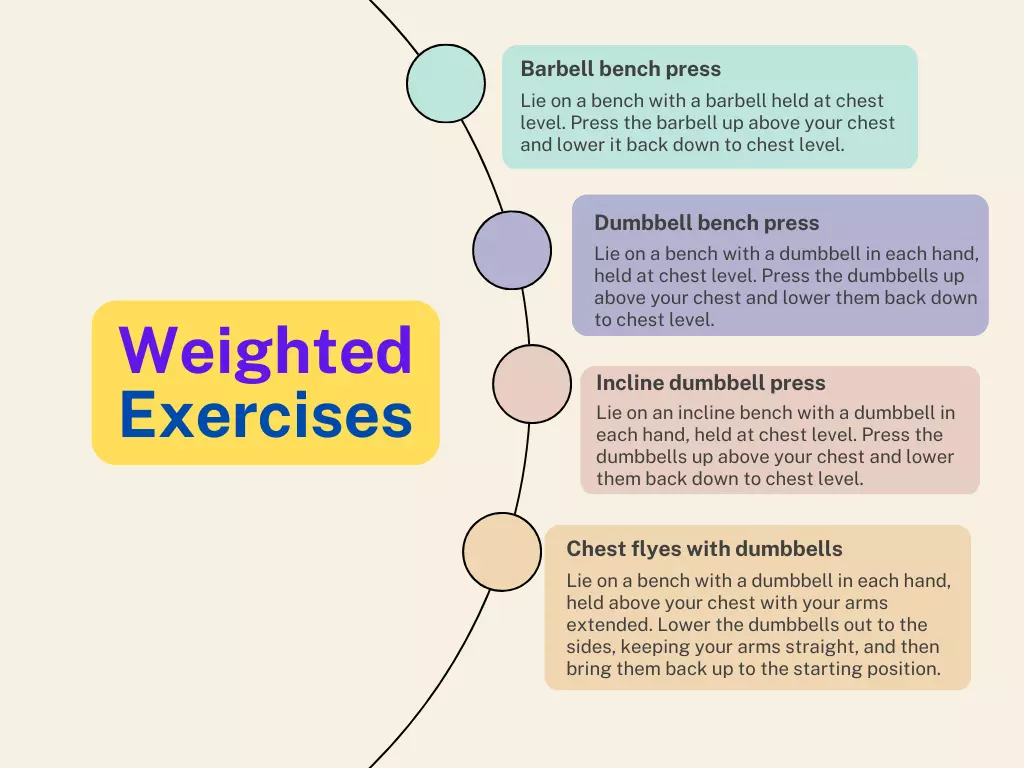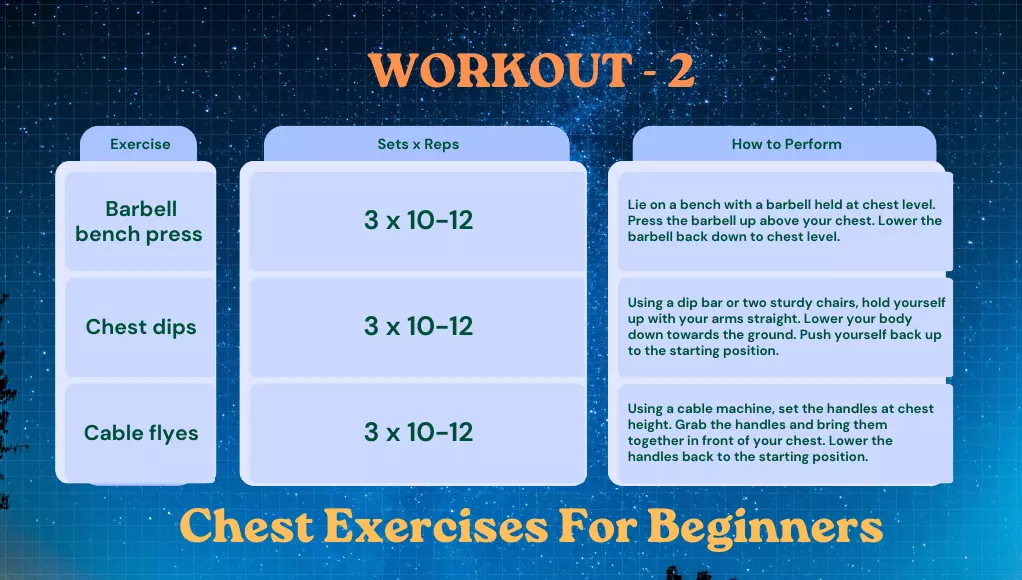Are you a beginner in the fitness world and looking to pump up your pecs? Look no further than chest exercises for Beginners! Chest exercises are an essential component of any fitness routine, whether you’re a bodybuilder or just looking to get in shape.
In this article, we’ll discuss the importance of chest exercises, the benefits of incorporating them into your fitness routine, and how to get started with chest exercises as a beginner. So, let’s get started!
The Importance of Chest Exercises for Beginners
Your chest muscles are an essential part of your upper body strength and play a crucial role in many everyday activities, such as pushing, pulling, and lifting. Neglecting your chest muscles can lead to a disproportionate upper body, weak posture, and even increase your risk of injury.
Benefits of Incorporating Chest Exercises for Beginners
Incorporating chest exercises into your fitness routine offers many benefits, such as:
| Tips for Getting Started with Chest Exercises for Beginners | EXPLANATION |
|---|---|
| ✔️ Consult with a fitness professional or personal trainer to create a workout plan that’s right for you. | It’s always a good idea to consult with a fitness professional or personal trainer before starting any new exercise routine, especially if you’re a beginner. They can help you create a workout plan that’s tailored to your fitness level, goals, and any health concerns you may have. This can help you avoid injury and get the most out of your workouts. |
| ✔️ Start with bodyweight exercises, such as push-ups, to build strength and proper form. | Bodyweight exercises are a great way to build strength and proper form without needing any equipment. Push-ups, in particular, are a great way to target your chest muscles, as well as your shoulders, triceps, and core. Start with a modified push-up, such as a knee push-up, if you need to build up your strength. |
| ✔️ Gradually increase the intensity and difficulty of your chest exercises over time. | As you get stronger and more comfortable with chest exercises, it’s important to challenge yourself by increasing the intensity and difficulty of your workouts. This can include adding more repetitions, trying different variations of exercises, or using weights or resistance bands. Just be sure to progress slowly and safely to avoid injury. |
| ✔️ Incorporate both compound and isolation chest exercises into your routine to work all areas of your chest. | Compound exercises, such as push-ups and bench press, work multiple muscle groups at the same time, including your chest, shoulders, and triceps. Isolation exercises, such as chest flyes and cable crossovers, target specific areas of your chest. Incorporating both types of exercises into your routine can help you work all areas of your chest and achieve a well-rounded, balanced physique. |
| ✔️ Improve upper body strength. | Chest exercises are great for improving upper body strength, which can help you perform better in many other activities, such as lifting, carrying, and throwing. Strong chest muscles also improve your posture and can reduce your risk of shoulder and back injuries. |
| ✔️ Reduce the risk of injury. | By strengthening your chest muscles, you can improve your posture and reduce your risk of injury, particularly to your shoulders and back. This is important for anyone who spends a lot of time sitting or performing repetitive movements. |
| ✔️ Enhance overall fitness performance. | Chest exercises are essential for many athletic activities, such as running, swimming, and weightlifting. By incorporating chest exercises into your routine, you can improve your overall fitness performance and achieve your goals more quickly and effectively. |
How to Get Started with Chest Exercises for Beginners
| Tips for Getting Started with Chest Exercises for Beginners |
|---|
| ✔️ Consult with a fitness professional or personal trainer to create a workout plan that’s right for you. |
| ✔️ Start with bodyweight exercises, such as push-ups, to build strength and proper form. |
| ✔️ Gradually increase the intensity and difficulty of your chest exercises over time. |
| ✔️ Incorporate both compound and isolation chest exercises into your routine to work all areas of your chest. |
| ✔️ Improve upper body strength. |
| ✔️ Reduce the risk of injury. |
| ✔️ Enhance overall fitness performance. |
If you’re new to fitness or chest exercises, it can be overwhelming to know where to start. Here are a few tips to help you get started:
- Consult with a fitness professional or personal trainer to create a workout plan that’s right for you.
- Start with bodyweight exercises, such as push-ups, to build strength and proper form.
- Gradually increase the intensity and difficulty of your chest exercises over time.
- Incorporate both compound and isolation chest exercises into your routine to work all areas of your chest.
By following these tips, you’ll be well on your way to achieving a strong, toned chest.
In conclusion, chest exercises are an essential component of any fitness routine, regardless of your fitness level or goals. By incorporating chest exercises into your workouts, you’ll improve your upper body strength, reduce your risk of injury, and enhance your overall fitness performance. So, what are you waiting for? Get started on your chest exercises today and watch your pecs grow!
Anatomy of the Chest Muscles:
Before you dive into chest exercises, it’s essential to understand the anatomy of your chest muscles. Knowing your chest muscles’ structure and function will help you perform exercises correctly and efficiently, preventing injury and maximizing your results.
Overview of the Chest Muscles
Your chest muscles consist of two primary muscles: the pectoralis major and the pectoralis minor. The pectoralis major is the larger of the two muscles, located on the front of your chest. It’s responsible for shoulder flexion, adduction, and internal rotation. The pectoralis minor is located underneath the pectoralis major and helps stabilize the scapula.
Importance of Understanding Chest Anatomy
Understanding chest anatomy is crucial when performing chest exercises to ensure that you’re targeting the correct muscles and performing the exercises correctly. For example, different chest exercises can target specific parts of the chest muscles, such as the upper or lower chest. By understanding chest anatomy, you can tailor your exercises to target specific areas that you want to develop.
How Chest Muscles Work
Your chest muscles work in conjunction with your shoulders, back, and arms to perform everyday tasks such as pushing and lifting. During chest exercises, the pectoralis major and minor contract, causing your arms to move toward your chest. Compound chest exercises such as bench press, involve multiple muscle groups, including the chest, shoulders, and triceps.
In conclusion, understanding chest anatomy is crucial when performing chest exercises. Knowing the structure and function of your chest muscles will help you target specific areas and perform exercises correctly, maximizing your results and minimizing your risk of injury. So, take the time to learn about your chest muscles before starting your chest exercise routine.
Types of Chest Exercises For Beginners:
Ready to get started on your chest exercise routine? There are many different types of chest exercises to choose from, each with their own benefits and advantages. In this article, we’ll explore four types of chest exercises: compound exercises, isolation exercises, bodyweight exercises, and weighted exercises.
Compound Exercises
Compound exercises are exercises that work multiple muscle groups at once. For chest development, compound exercises are an effective way to target the chest muscles while also engaging other muscle groups. Some examples of compound exercises for chest development include:
- Barbell bench press
- Dumbbell bench press
- Push-ups
- Chest dips

Isolation Exercises
Isolation exercises are exercises that target a specific muscle group. For chest development, isolation exercises can be used to target specific areas of the chest. Some examples of isolation exercises for chest development include:
- Cable flyes
- Pec deck machine
- Chest press machine
- Dumbbell flyes

Bodyweight Exercises
Bodyweight exercises are exercises that use your own body weight as resistance. These exercises are great for beginners because they require no equipment and can be done anywhere. Some examples of bodyweight chest exercises include:
- Push-ups
- Incline push-ups
- Decline push-ups
- Wide-grip push-ups

Weighted Exercises
Weighted exercises are exercises that use external weights, such as dumbbells or barbells, to provide resistance. These exercises are great for building strength and muscle mass. Some examples of weighted chest exercises include:
- Barbell bench press
- Dumbbell bench press
- Incline dumbbell press
- Chest flyes with dumbbells

In conclusion, there are many different types of chest exercises to choose from. Compound exercises and isolation exercises are great for targeting specific muscle groups, while bodyweight exercises and weighted exercises provide different advantages. Incorporating a variety of these exercises into your chest routine will help you achieve a strong, toned chest.
Chest Exercises For Beginners:
Are you a beginner looking for an effective chest workout? Look no further! Here are two beginner chest workouts that will help you build a strong, toned chest.
Beginner Chest Workout 1
Push-ups – 3 sets of 10-12 reps
-Start in a plank position with your hands slightly wider than shoulder-width apart.
-Lower your body until your chest almost touches the ground.
-Push back up to the starting position.
Dumbbell bench press – 3 sets of 10-12 reps
-Lie on a bench with a dumbbell in each hand, held at chest level.
-Press the dumbbells up above your chest.
-Lower the dumbbells back down to chest level.
Incline dumbbell flyes – 3 sets of 10-12 reps
-Lie on an incline bench with a dumbbell in each hand.
-Extend your arms out to the side, parallel to the floor.
-Lower the dumbbells down towards the ground, keeping your arms straight.
-Bring the dumbbells back up to the starting position.

Beginner Chest Workout 2
Barbell bench press – 3 sets of 10-12 reps
-Lie on a bench with a barbell held at chest level.
-Press the barbell up above your chest.
-Lower the barbell back down to chest level.
Chest dips – 3 sets of 10-12 reps
-Using a dip bar or two sturdy chairs, hold yourself up with your arms straight.
-Lower your body down towards the ground.
Push yourself back up to the starting position.
Cable flyes – 3 sets of 10-12 reps
-Using a cable machine, set the handles at chest height.
-Grab the handles and bring them together in front of your chest.
-Lower the handles back to the starting position.

Incorporate these two beginner chest workouts into your fitness routine to start building a strong, toned chest!
Chest Exercises For Beginners – Form and Technique:
When it comes to chest exercises, form and technique are key to getting the most out of your workout and avoiding injury. Here’s why proper form and technique matter, as well as some common mistakes beginners make and how to correct them.
Importance of Proper Form and Technique
Proper form and technique during chest exercises ensure that you are targeting the right muscles and minimizing the risk of injury. Correct form also ensures that you are performing the exercise in a way that is most effective for building strength and muscle.
Common Mistakes Beginners Make
| Common Mistakes Beginners Make | Explanation |
|---|---|
| Using too much weight | Beginners often make the mistake of choosing a weight that is too heavy, which can lead to poor form and injury. It’s important to start with a weight that you can handle comfortably and gradually increase the weight over time. |
| Arching your back | Arching your back while doing chest exercises can put unnecessary strain on your lower back and take the focus off your chest muscles. It’s important to maintain a neutral spine and engage your core while doing chest exercises. |
| Flaring your elbows | Flaring your elbows outwards while doing chest exercises puts more emphasis on your shoulders and can lead to injury. Keep your elbows close to your body to engage your chest muscles effectively. |
| Not using a full range of motion | Going through the full range of motion ensures that you are fully engaging your chest muscles. Not doing so can limit your progress and results. It’s important to focus on the quality of your movements rather than the quantity of reps. |
How to Correct Common Form and Technique Errors
| How to Correct Common Form and Technique Errors | Explanation |
|---|---|
| Reduce the weight | Starting with a weight that you can handle comfortably and gradually increasing it over time will help you build strength and proper form, while reducing the risk of injury. |
| Focus on keeping your back flat on the bench | Keeping your back flat on the bench during chest exercises will help you maintain proper form and focus on engaging your chest muscles, rather than putting strain on your lower back. |
| Keep your elbows tucked in | Keeping your elbows tucked in will help you engage your chest muscles and reduce the risk of injury by preventing unnecessary strain on your shoulders. |
| Use a full range of motion | Going through the full range of motion for each exercise will help you fully engage your chest muscles and get the most out of your workout. Focusing on proper form and technique during chest exercises will maximize their benefits while minimizing the risk of injury. |
By paying attention to your form and technique, you can maximize the benefits of your chest exercises while minimizing the risk of injury.
Chest Exercises For Beginners – Equipment:
To perform chest exercises, you don’t necessarily need a lot of equipment. Here are some options for both home and gym workouts.
Equipment Needed for Chest Exercises
- Bench: A bench is a versatile piece of equipment that can be used for many different chest exercises, including the bench press and dumbbell flys.
- Dumbbells: Dumbbells are an effective tool for building chest strength and can be used for exercises like chest press and flys.
- Barbells: Barbells are another option for exercises like the bench press and can be used to increase the weight as you get stronger.
- Resistance bands: Resistance bands are a portable and versatile tool that can be used for chest exercises like push-ups and flys.
Home Equipment Options for Chest Exercises
- Push-up bars: These provide added stability and can help reduce stress on your wrists during push-ups.
- Suspension trainer: A suspension trainer like TRX can be used for a variety of chest exercises and can be easily set up in a home gym.
- Adjustable bench: An adjustable bench can be used for a variety of exercises, including chest press and flys, and can be adjusted to different angles for different variations.
Gym Equipment Options for Chest Exercises
- Cable machines: Cable machines provide a variety of options for chest exercises and can be used to work different parts of the chest muscles.
- Chest press machine: This machine targets the chest muscles and can be adjusted to different angles and resistance levels.
- Chest fly machine: This machine targets the chest muscles and can be used to build strength and size.
Regardless of the equipment you have access to, there are plenty of chest exercises you can do to build strength and muscle.
Chest Exercises For Beginners – Tips:
Here are some tips for beginners to help you get the most out of your chest workouts:
How to Warm Up Before a Chest Workout
Warming up before any workout is essential to prevent injury and get your muscles ready for the work ahead. Here are some tips for warming up before a chest workout:
- Start with 5-10 minutes of light cardio to get your heart rate up and increase blood flow to your muscles.
- Do some dynamic stretching exercises to help improve your range of motion and loosen up your chest muscles.
- Use lighter weights or resistance bands to perform a few sets of the exercises you’ll be doing in your workout to prepare your muscles for the heavier weights to come.
How to Progress Your Chest Exercises Over Time
As you get stronger, it’s important to continually challenge yourself to avoid hitting a plateau in your progress. Here are some ways to progress your chest exercises over time:
- Increase the weight: Gradually increase the amount of weight you’re using for each exercise to continue challenging your muscles.
- Change the angle: Changing the angle of your exercises can help target different parts of your chest muscles and prevent boredom.
- Try new exercises: Incorporating new exercises into your routine can help you work different parts of your chest and prevent overuse injuries.
How Often to Do Chest Exercises
The frequency of your chest workouts depends on your fitness goals and overall workout routine. Here are some general guidelines:
- Beginners: Aim to do chest exercises 1-2 times per week, with at least one day of rest in between workouts.
- Intermediate and advanced: Depending on your fitness goals, you can increase the frequency of your chest workouts to 2-3 times per week, with at least one day of rest in between workouts.
It’s important to listen to your body and adjust your workout routine as needed to prevent overtraining and injury.
Keto Nutrition Pyramid: A Game-Changer for those Struggling to Stick to a Diet
Conclusion: Chest Exercises For Beginners
In conclusion, chest exercises are essential for anyone looking to improve their upper body strength and overall fitness level. Whether you’re a beginner or an experienced gym-goer, incorporating a variety of chest exercises into your workout routine can help you achieve your fitness goals.
Remember to start with the basics, such as push-ups and bench press variations, and gradually progress to more challenging exercises as you get stronger. Always focus on proper form and technique, and listen to your body to avoid injury.
By following these tips and incorporating chest exercises into your regular workout routine, you’ll be well on your way to building a stronger, more defined chest.
So, get ready to put in the work and enjoy the results!
FAQs: Chest Exercises For Beginners
Here are some frequently asked questions about chest exercises for beginners:
1. What is the best chest exercise for beginners?
The best chest exercise for beginners is the push-up. It’s a compound exercise that targets multiple muscles in the chest, shoulders, and arms. Other great exercises for beginners include chest press, dumbbell flyes, and chest dips.
2. Can I do chest exercises every day?
It’s not recommended to do chest exercises every day. Your muscles need time to recover and grow, so it’s best to allow at least 24 to 48 hours of rest between chest workouts. Overtraining can lead to injury and hinder your progress.
3. How long does it take to see results from Chest Exercises For Beginners?
The time it takes to see results from chest exercises varies from person to person. With consistent training and a proper nutrition plan, you can expect to see noticeable improvements in your chest strength and definition within a few weeks to a few months.
4. Do I need a gym membership to do Chest Exercises For Beginners?
No, you don’t need a gym membership to do chest exercises. There are plenty of effective bodyweight chest exercises you can do at home, such as push-ups, chest dips, and dumbbell flyes. However, if you have access to a gym, there are many additional equipment options that can help you vary your workouts and increase your intensity.
5. How many sets and reps should I do for Chest Exercises For Beginners?
The number of sets and reps you should do for chest exercises depends on your fitness goals and experience level. As a beginner, aim for 3 to 4 sets of 8 to 12 reps for each exercise. As you get stronger and more experienced, you can increase your sets and reps to challenge yourself and continue making progress.





